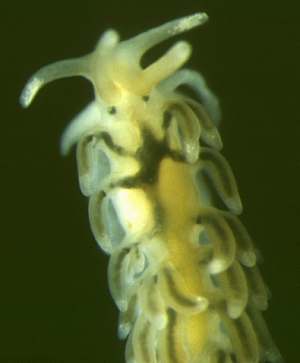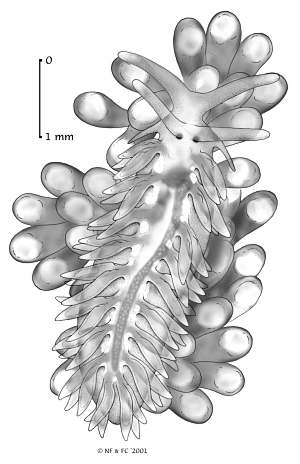

Calma gobioophaga
Calado & Urgorri, 2002
Order: NUDIBRANCHIA
Suborder: AEOLIDINA
Family: Calmidae
DISTRIBUTION
Atlantic coast of Europe. Known at present from Portugal to the western end of the Mediterranean.
The genus Calma consists of two species from the Atlantic coast of Europe which feed exclusively on fish eggs. One anatomical peculiarity is their lack of an anus, which is considered to have evolved because the high protein egg diet results in little or no waste. The two species are very similar anatomically, C. gobioophaga only recently being separated from Calma glaucoides (Alder & Hancock, 1854).
The two species do however differ consistently in some morphological characters. In body length and width, C. glaucoides is wider and longer. The position of the kidney differs between species, being between the 2nd and the 6th (rarely 5th or 7th) ceratal group in C. glaucoides and between the 2nd and the last ceratal group in C. gobioophaga. The size and position of the eyes also differs, being about 80 µm, and positioned behind the rhinophores in the space between these and the first group of cerata in C. glaucoides, and 110 µm, and immediately behind the rhinophores in C. gobioophaga. The form and size of the propodial tentacles also differs, being small and acute in C. glaucoides and large and finger-like in C. gobioophaga.
However the most distinctive difference is ecological. At least during non-larval life, both species occupy different ecological niches. Whereas Calma gobioophaga feeds only on the spawn of Gobius niger, Calma glaucoides feeds on eggs of Lepadogaster lepadogaster, Lepadogaster purpurea, Lepadogaster candollei, Parablennius gattorugine and Parablennius pilicornis.
Reference:
Calado, G. & V. Urgorri, 2002. A new species of Calma Alder & Hancock, 1855 (Gastropoda: Nudibranchia) with a review of the genus. Journal of Molluscan Studies, 68: 311-317.
Rudman, W.B., 2002 (October 25) Calma gobioophaga Calado & Urgorri, 2002 . [In] Sea Slug Forum. Australian Museum, Sydney. Available from http://www.seaslugforum.net/find/calmgobi
Related messages
Calma gobioophaga - a new fish egg predator
October 27, 2002
From: Gonçalo Calado


Dear Bill
The description of a new species of the genus Calma has just been published. Calma glaucoides (Alder & Hancock, 1854) and Calma gobioophaga Calado & Urgorri, 2002 differ consistently in some morphological characters, such as body length and width - C. glaucoides is wider and longer. In the position of the kidney - between the 2nd and the 6th (rarely 5th or 7th) ceratal group in C. glaucoides and between the 2nd and the last ceratal group in C. gobioophaga. In the size and position of the eyes - 80 µm, behind the rhinophores, in the space between these and the first group of cerata in C. glaucoides and 110 µm immediately behind the rhinophores or in its rear border in C. gobioophaga. And in the form and size of the propodial tentacles - small and acute in C. glaucoides and large and finger-like in C. gobioophaga.
Nevertheless, the most important difference is ecological. At least during non-larval life, both species occupy different ecological niches. Whereas Calma gobioophaga feeds on spawn of Gobius niger, Calma glaucoides feeds on eggs of Lepadogaster lepadogaster, Lepadogaster purpurea, Lepadogaster candollei, Parablennius gattorugine and Parablennius pilicornis.
Reference:
Calado, G. & V. Urgorri, 2002 A new species of Calma Alder & Hancock, 1855 (Gastropoda: Nudibranchia) with a review of the genus. Journal of Molluscan Studies, 68: 311-317.
Best wishes,
Gonçalo
bagoncas@mail.telepac.pt
Calado, G., 2002 (Oct 27) Calma gobioophaga - a new fish egg predator. [Message in] Sea Slug Forum. Australian Museum, Sydney. Available from http://www.seaslugforum.net/find/8268Dear Gonçalo,
Thanks for keeping us informed about your work. For the sake of completeness, I have repeated this message under both species. It is exciting when ecological data can so definitively show the difference between two species. It again demonstrates the value of noting any information we possibly can on aspects of natural history when collecting and photographing these fascinating animals. Best wishes,
Bill Rudman
